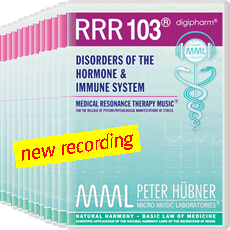|
| SCIENTIFICALLY INTRODUCING UNIVERSALITY TO THE UNIVERSITY |
|
| peter huebner • micro music laboratories |
| M E D I C A L R E S O N A N C E T H E R A P Y M U S I C® |
| R E D U C T I O N O F P S Y C H O – P H Y S I O L O G I C A L M A N I F E S T A T I O N S O F S T R E S S |
Scientific Studies and Clinical Observations
| DISORDERS OF THE HORMONE & IMMUNE SYSTEM |
- Normalization of the immunogram after two weeks in 25% of a group of children suffering from radiation sickness
- Stimulation of hormone levels which were too low in patients suffering from severe radiation sickness: hormone production was increasingly stimulated in each musical treatment and during the tenth application of the music the level rose by 60% to reach a normal level
- Improvement of the kariopicnotic index (KPI) in risk pregnancies: in the Medical Resonance Therapy Music® group the KPI first fell to 10-12%, after 6 days to 7-8%, after 9 days to 6-8%. In the control group it first fell to 14-17%, after 6 days to 11-13%, after 9 days to 9-10% – so significantly less. The fall in the KPI shows a significant improvement in the course of the pregnancy
- Improvement in the hormone status in risk pregnancies: reduction of the cortisol level by 36% (double compared to that in the control group) coupled with a simultaneous increase in the progesterone level by 100% (almost four times as much as in the control group). The lowering of the cortisol level minimizes the stress risk-factor threatening the pregnancy, whilst the doubling of the progesterone increases the well-being of mother and child
- Calming of the hormone system in women during labor through the reduction of stress-induced hormonal manifestations
- Improvement in the hormone status in pregnant women with somatic disorders: increase in the placentalactogen content from 217.5 nmol/l to 274.9 nmol/l and of the estriol level from 80.0 µ mol/24 hours to 103.3 µ mol/24 hours, leading to an improvement in the well-being of the mother and child
- Normalization of the immune status in 56% of pregnant women from a group under the threat of miscarriage. In the control group the immune status normalized in 46% of the pregnant women
If you want to look at the studies in detail, please visit:
